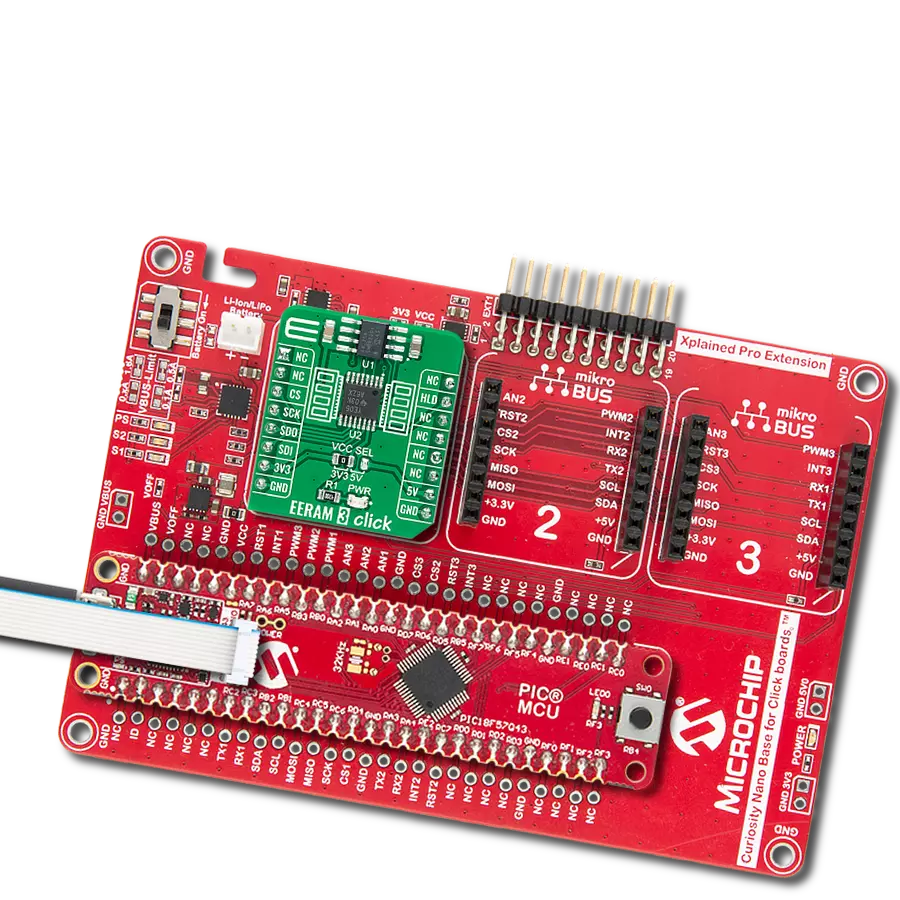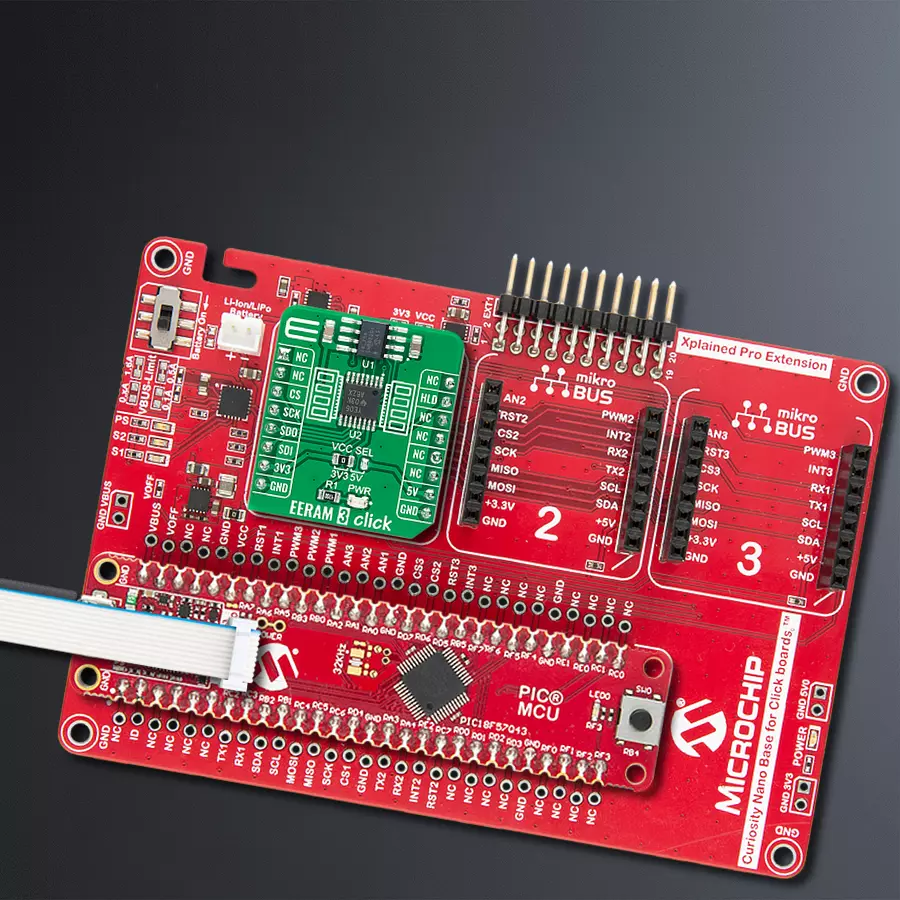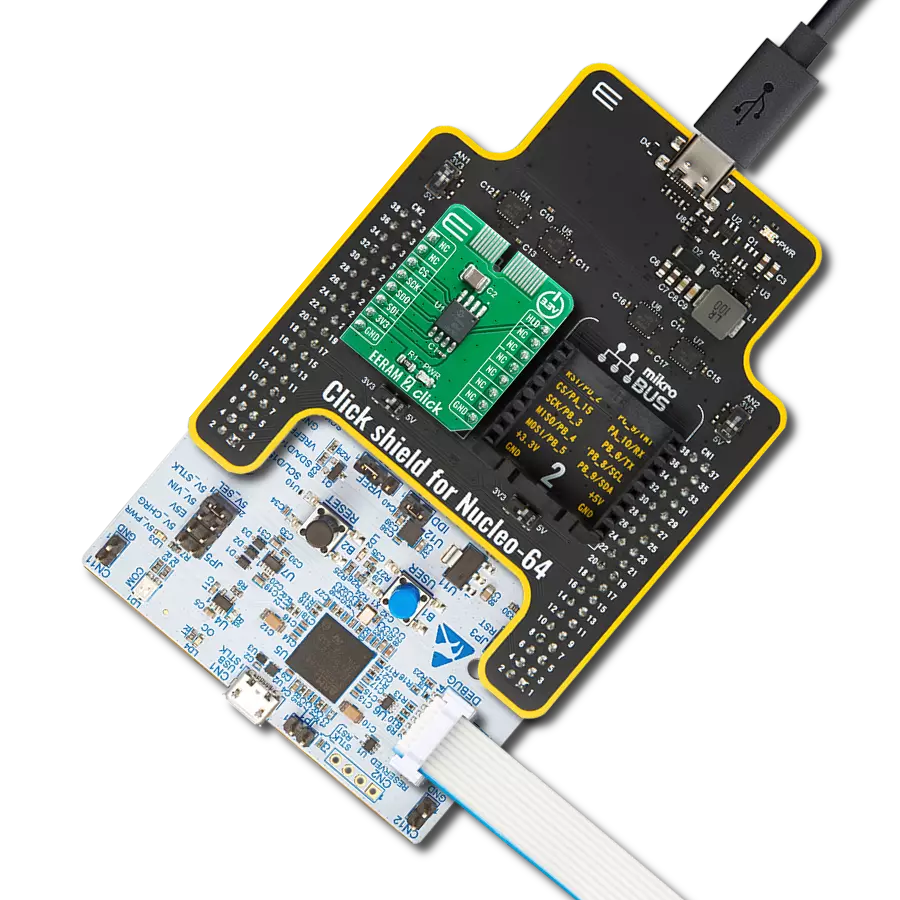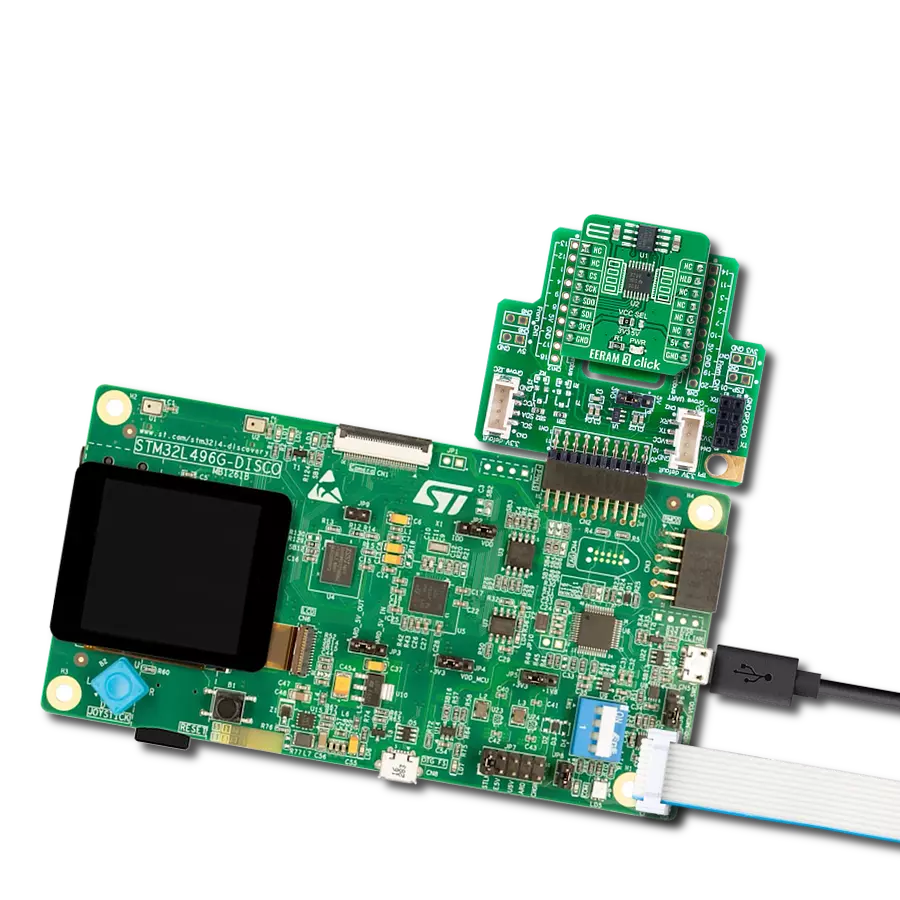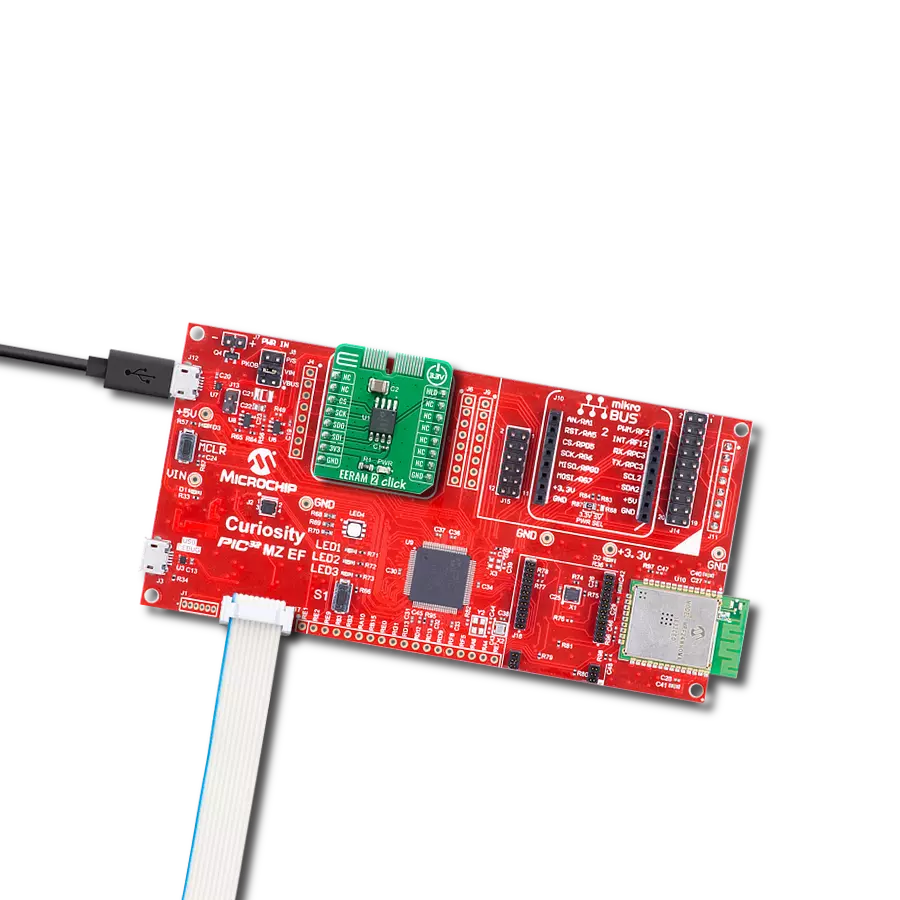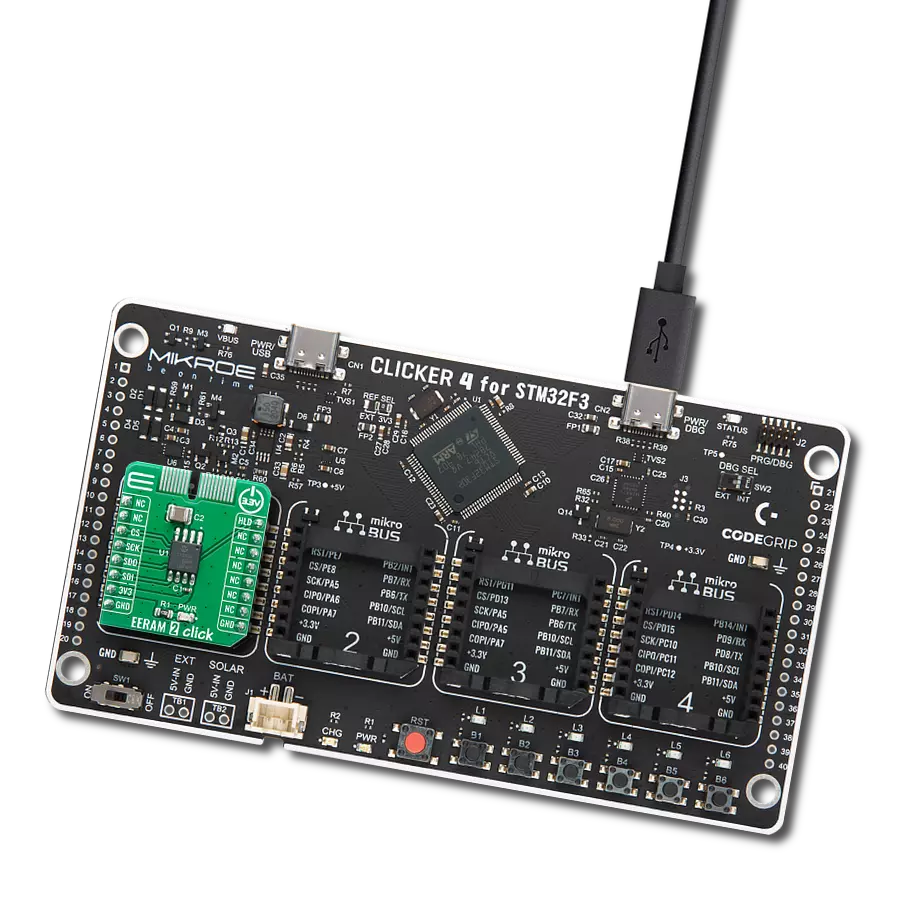Ensure higher protection against unauthorized access by incorporating serial EERAM to store encryption keys, secure boot information, and authentication credentials
A
A
Hardware Overview
How does it work?
EERAM 3 Click is based on the 48L256, an SPI nonvolatile EERAM memory IC designed to retain data when power is disrupted from Microchip. The user can treat this Click board™ as a full symmetrical read/write SRAM: it allows symmetrical reads and writes and has no limits on cell usage. It is structured as a 256-Kbit SRAM with EEPROM backup in each memory cell, where SRAM is organized as 32,768x8 bits. The 48L256 specifies 100.000 endurance cycles with data retention of a minimum of 10 years, which gives the 48L256 the unique capability to handle unlimited reads/writes to the memory. The backup EEPROM is invisible to the user and cannot be accessed by the user independently. The 48L256 includes circuitry that detects VCC voltage dropping below a certain threshold, shuts its connection to the outside environment, and
transfers all SRAM data to the EEPROM portion of each cell for safekeeping. When VCC returns, the circuitry automatically returns the data to the SRAM, and the user’s interaction with the SRAM can continue with the same data set. The 48L256 communicates with MCU through a standard SPI interface that enables very high clock speeds up to 66MHz, supporting the two most common SPI modes - SPI Mode 0 and 3, and a proper logic voltage level conversion performed by the appropriate voltage level translator. The VCC logic level provides a needed reference voltage for one side of the TXB0106, a 6-bit bidirectional level shifting, and a voltage translator with automatic direction sensing from Texas Instruments. On another side of the level shifter, the reference voltage is taken from the 3.3V mikroBUS™ power rail. Another feature of this Click board™
represents the configurable HOLD function labeled as HLD routed on the INT pin of the mikroBUS™ socket. The HLD pin suspends transmission to the 48L256 while in the middle of a serial sequence without re-transmitting the entire sequence. It must be held high any time this function is not being used. Once the device is selected and a serial sequence is underway, the HLD pin may be pulled low to pause further serial communication without resetting the serial sequence. This Click board™ can operate with either 3.3V or 5V logic voltage levels selected via the VCC SEL jumper. This way, both 3.3V and 5V capable MCUs can use the communication lines properly. Also, this Click board™ comes equipped with a library containing easy-to-use functions and an example code that can be used, as a reference, for further development.
Features overview
Development board
PIC18F57Q43 Curiosity Nano evaluation kit is a cutting-edge hardware platform designed to evaluate microcontrollers within the PIC18-Q43 family. Central to its design is the inclusion of the powerful PIC18F57Q43 microcontroller (MCU), offering advanced functionalities and robust performance. Key features of this evaluation kit include a yellow user LED and a responsive
mechanical user switch, providing seamless interaction and testing. The provision for a 32.768kHz crystal footprint ensures precision timing capabilities. With an onboard debugger boasting a green power and status LED, programming and debugging become intuitive and efficient. Further enhancing its utility is the Virtual serial port (CDC) and a debug GPIO channel (DGI
GPIO), offering extensive connectivity options. Powered via USB, this kit boasts an adjustable target voltage feature facilitated by the MIC5353 LDO regulator, ensuring stable operation with an output voltage ranging from 1.8V to 5.1V, with a maximum output current of 500mA, subject to ambient temperature and voltage constraints.
Microcontroller Overview
MCU Card / MCU
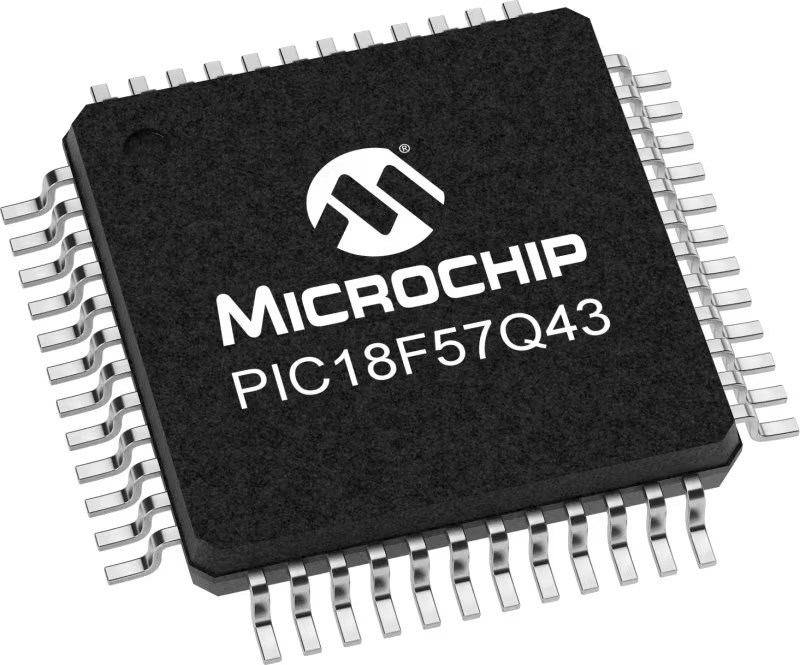
Architecture
PIC
MCU Memory (KB)
128
Silicon Vendor
Microchip
Pin count
48
RAM (Bytes)
8196
You complete me!
Accessories
Curiosity Nano Base for Click boards is a versatile hardware extension platform created to streamline the integration between Curiosity Nano kits and extension boards, tailored explicitly for the mikroBUS™-standardized Click boards and Xplained Pro extension boards. This innovative base board (shield) offers seamless connectivity and expansion possibilities, simplifying experimentation and development. Key features include USB power compatibility from the Curiosity Nano kit, alongside an alternative external power input option for enhanced flexibility. The onboard Li-Ion/LiPo charger and management circuit ensure smooth operation for battery-powered applications, simplifying usage and management. Moreover, the base incorporates a fixed 3.3V PSU dedicated to target and mikroBUS™ power rails, alongside a fixed 5.0V boost converter catering to 5V power rails of mikroBUS™ sockets, providing stable power delivery for various connected devices.
Used MCU Pins
mikroBUS™ mapper
Take a closer look
Click board™ Schematic

Step by step
Project assembly
Track your results in real time
Application Output
1. Application Output - In Debug mode, the 'Application Output' window enables real-time data monitoring, offering direct insight into execution results. Ensure proper data display by configuring the environment correctly using the provided tutorial.

2. UART Terminal - Use the UART Terminal to monitor data transmission via a USB to UART converter, allowing direct communication between the Click board™ and your development system. Configure the baud rate and other serial settings according to your project's requirements to ensure proper functionality. For step-by-step setup instructions, refer to the provided tutorial.

3. Plot Output - The Plot feature offers a powerful way to visualize real-time sensor data, enabling trend analysis, debugging, and comparison of multiple data points. To set it up correctly, follow the provided tutorial, which includes a step-by-step example of using the Plot feature to display Click board™ readings. To use the Plot feature in your code, use the function: plot(*insert_graph_name*, variable_name);. This is a general format, and it is up to the user to replace 'insert_graph_name' with the actual graph name and 'variable_name' with the parameter to be displayed.

Software Support
Library Description
This library contains API for EERAM 3 Click driver.
Key functions:
eeram3_memory_secure_write- This function securely writes a desired number of data bytes starting from the selected memory addresseeram3_memory_secure_read- This function securely reads a desired number of data bytes starting from the selected memory addresseeram3_set_block_protection- This function sets the block protection bits of the Status register.
Open Source
Code example
The complete application code and a ready-to-use project are available through the NECTO Studio Package Manager for direct installation in the NECTO Studio. The application code can also be found on the MIKROE GitHub account.
/*!
* @file main.c
* @brief EERAM3 Click example
*
* # Description
* This example demonstrates the use of EERAM 3 Click board.
*
* The demo application is composed of two sections :
*
* ## Application Init
* Initializes the driver and performs the Click default configuration.
*
* ## Application Task
* Writes a desired number of bytes to the memory and then verifies that it's written correctly
* by reading from the same memory location and displaying the memory content on the USB UART.
*
* @author Stefan Filipovic
*
*/
#include "board.h"
#include "log.h"
#include "eeram3.h"
#define DEMO_TEXT_MESSAGE "MikroE - EERAM 3 Click board"
#define STARTING_ADDRESS 0x1000
static eeram3_t eeram3;
static log_t logger;
void application_init ( void )
{
log_cfg_t log_cfg; /**< Logger config object. */
eeram3_cfg_t eeram3_cfg; /**< Click config object. */
/**
* Logger initialization.
* Default baud rate: 115200
* Default log level: LOG_LEVEL_DEBUG
* @note If USB_UART_RX and USB_UART_TX
* are defined as HAL_PIN_NC, you will
* need to define them manually for log to work.
* See @b LOG_MAP_USB_UART macro definition for detailed explanation.
*/
LOG_MAP_USB_UART( log_cfg );
log_init( &logger, &log_cfg );
log_info( &logger, " Application Init " );
// Click initialization.
eeram3_cfg_setup( &eeram3_cfg );
EERAM3_MAP_MIKROBUS( eeram3_cfg, MIKROBUS_1 );
if ( SPI_MASTER_ERROR == eeram3_init( &eeram3, &eeram3_cfg ) )
{
log_error( &logger, " Application Init Error. " );
log_info( &logger, " Please, run program again... " );
for ( ; ; );
}
eeram3_default_cfg ( &eeram3 );
log_info( &logger, " Application Task " );
}
void application_task ( void )
{
uint8_t data_buf[ 64 ] = { 0 };
if ( EERAM3_OK == eeram3_memory_secure_write ( &eeram3, STARTING_ADDRESS,
DEMO_TEXT_MESSAGE, strlen ( DEMO_TEXT_MESSAGE ) ) )
{
log_printf ( &logger, "Data written to address 0x%.4X: %s\r\n", ( uint16_t ) STARTING_ADDRESS,
( char * ) DEMO_TEXT_MESSAGE );
}
Delay_ms ( 100 );
if ( EERAM3_OK == eeram3_memory_secure_read ( &eeram3, STARTING_ADDRESS,
data_buf, strlen ( DEMO_TEXT_MESSAGE ) ) )
{
log_printf ( &logger, "Data read from address 0x%.4X: %s\r\n\n", ( uint16_t ) STARTING_ADDRESS,
data_buf );
}
Delay_ms ( 1000 );
}
int main ( void )
{
/* Do not remove this line or clock might not be set correctly. */
#ifdef PREINIT_SUPPORTED
preinit();
#endif
application_init( );
for ( ; ; )
{
application_task( );
}
return 0;
}
// ------------------------------------------------------------------------ END
Additional Support
Resources
Category:EERAM
